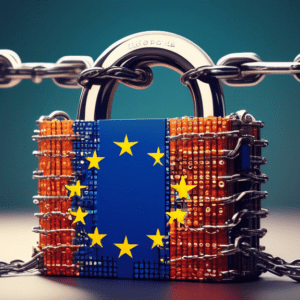A Deep Dive into the Regulatory Landscape and Potential Risks
The European Union (EU) has long been at the forefront of digital regulation, striving to strike a balance between fostering innovation and protecting its citizens. Recently, EU agencies have amplified their concerns regarding the use of encryption and cryptocurrencies, highlighting the potential risks they pose to security, financial stability, and law enforcement efforts. This in-depth analysis delves into the crux of these concerns, examining the regulatory landscape and the potential implications for the future of these technologies within the EU.
Understanding the EU’s Stance on Encryption
Encryption, the process of converting data into an unreadable format, lies at the heart of digital privacy and security. It safeguards sensitive information, from personal messages to financial transactions, from unauthorized access. However, the same technology that empowers individuals to protect their privacy can be exploited by criminals seeking to operate under the radar.
EU agencies, including Europol (the EU’s law enforcement agency) and the European Banking Authority (EBA), have voiced apprehensions about the increasing use of end-to-end encryption, where only the communicating users hold the decryption keys. While acknowledging the importance of privacy, they argue that strong encryption can create a situation where law enforcement agencies are left blind when investigating serious crimes, such as terrorism, child exploitation, and cybercrime.
The Rise of Cryptocurrencies and Associated Risks
Cryptocurrencies, digital or virtual currencies secured by cryptography, have witnessed a meteoric rise in popularity in recent years. Bitcoin, Ethereum, and a plethora of other cryptocurrencies offer a decentralized alternative to traditional financial systems. However, this decentralized and often anonymous nature has also raised red flags among regulators.
The EBA, in its assessments, has pointed out the volatility and potential for market manipulation in the cryptocurrency market. The lack of a central authority overseeing these assets makes them susceptible to price swings and fraudulent activities, potentially harming investors and threatening financial stability.
Furthermore, the anonymity afforded by some cryptocurrencies has made them attractive to criminals engaged in money laundering, terrorist financing, and other illicit activities. The ability to transfer large sums of money across borders with minimal oversight poses significant challenges for law enforcement agencies tasked with tracking financial flows related to criminal enterprises.
Navigating the Regulatory Landscape: A Balancing Act
The EU is actively working on a comprehensive framework to regulate cryptocurrencies and address the challenges posed by encryption. The proposed regulations aim to strike a balance between fostering innovation and mitigating risks without stifling the growth of these technologies.
Key Regulatory Initiatives:
- **Markets in Crypto-Assets (MiCA) Regulation:** This landmark regulation aims to create a harmonized legal framework for crypto-assets across the EU. It covers various aspects, including the issuance and trading of cryptocurrencies, consumer protection, and environmental considerations related to crypto mining.
- **Anti-Money Laundering (AML) Regulations:** The EU has strengthened its AML regulations to address the risks associated with cryptocurrencies. Cryptocurrency service providers, including exchanges and wallet providers, are now subject to the same AML/CFT (Combating the Financing of Terrorism) requirements as traditional financial institutions. This includes customer due diligence, transaction monitoring, and reporting suspicious activities.
- **ePrivacy Regulation:** While still under negotiation, the ePrivacy Regulation is set to replace the existing ePrivacy Directive. It aims to modernize rules on electronic communications, including provisions on the confidentiality of communications data. The regulation will have implications for the use of encryption in messaging services and other online platforms.
The Debate on Encryption Backdoors
One of the most contentious issues in the debate surrounding encryption is the concept of backdoors. Law enforcement agencies argue that access to encrypted data, even if limited and controlled, is crucial for investigating serious crimes. However, privacy advocates vehemently oppose any form of backdoor, arguing that it would fundamentally weaken encryption and make users vulnerable to hacking and surveillance.
The EU’s position on encryption backdoors remains a complex one. While acknowledging the concerns of law enforcement, the EU has reaffirmed its commitment to strong encryption. The challenge lies in finding alternative investigative techniques and tools that respect privacy while enabling effective law enforcement.
The Future of Encryption and Cryptocurrencies in the EU
The EU’s regulatory landscape for encryption and cryptocurrencies is still under development, but the direction is clear: a balanced approach that seeks to harness the benefits of these technologies while addressing the associated risks. The success of this endeavor will depend on several factors:
- **Effective Implementation and Enforcement:** The effectiveness of any regulation hinges on its implementation and enforcement. The EU must ensure that its regulatory framework is robust, clear, and consistently applied across all member states.
- **International Cooperation:** Given the borderless nature of digital technologies, international cooperation is essential. The EU is actively engaged in dialogues with international partners to establish common standards and address the cross-border implications of encryption and cryptocurrencies.
- **Technological Advancements:** The landscape of encryption and cryptocurrencies is constantly evolving. Regulators must remain agile and adaptable, constantly monitoring technological advancements and adjusting regulations accordingly. This includes exploring innovative solutions, such as privacy-enhancing technologies (PETs), that can enhance security and privacy without compromising law enforcement capabilities.
- **Open Dialogue:** A continuous and open dialogue between regulators, industry stakeholders, privacy advocates, and law enforcement agencies is crucial. Collaboration and information sharing will be key to striking the right balance and fostering a secure, trustworthy, and innovative digital environment.
Conclusion
The EU’s concerns over encryption and cryptocurrencies stem from a desire to protect its citizens and financial systems while fostering innovation. The challenge lies in finding a delicate balance between security, privacy, and innovation. By implementing a well-defined regulatory framework, promoting international cooperation, embracing technological advancements, and fostering an open dialogue, the EU can navigate the complexities of these technologies and harness their potential while mitigating the risks. The outcome of these efforts will shape not only the future of encryption and cryptocurrencies within the EU but also set a precedent for other regions grappling with similar challenges in the digital age.
